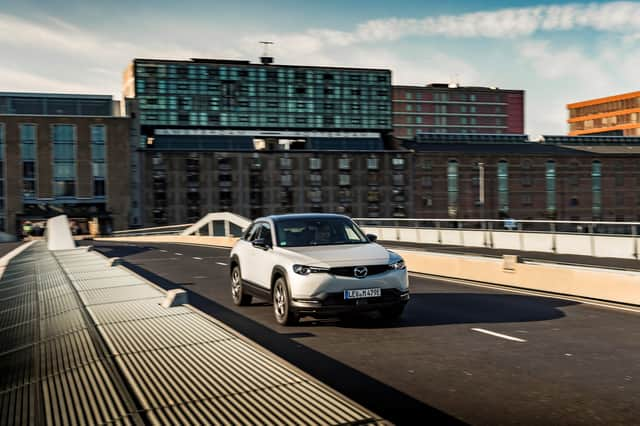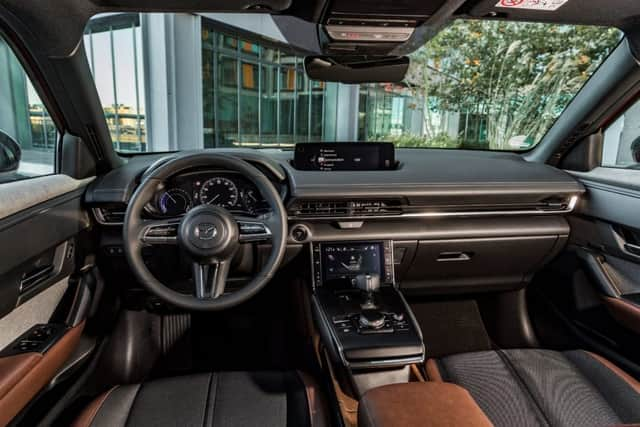Mazda MX-30 first drive


Let’s talk about doors. An unusual place to begin a first impression drive you might think but stick with me.
You see, one of the first things you notice about the Mazda MX-30 is that its doors are on back to front. Well, at least the rear ones are. Like the revolutionary RX-8 before it, Mazda’s brand-new electric SUV features a pair of rear-hinged suicide doors. Pop open the fronts and rather than a traditional B-pillar, there’s the leading edge of the rear doors and a handle to swing them open like a pair of welcoming arms.
Advertisement
Hide AdAdvertisement
Hide AdIt means the rear doors can be shorter than on a regular crossover, helping Mazda create the long-nosed coupe-inspired shape so beloved of B-segment SUV designers everywhere. It also continues Mazda’s tradition of distinctive design. The MX-30’s combination of flowing lines and squared-off arches is different enough to stand out without going over the top like some other EVs. The cab-rearward look with swooping roof works surprisingly well and fits into the broader Mazda family neatly.
The interior is a similar story, moving things on in places while staying true to the “simpler is better” approach seen in other models. I’m not convinced the move to a touchscreen for heating controls is a good idea but elsewhere the MX-30 is clear and simple, with well laid out controls and high-quality materials. Among them are a number of more environmentally friendly finishes including door-top fabrics made from recycling plastic bottles and, in a nod to Mazda’s origins, cork panels around the centre console.


Mazda MX-30
- Price: From £25,595 (after PICG)
- Motor: Single AC synchronous electric motor
- Power: 143bhp
- Torque: 199lb ft
- Transmission: Direct drive
- Top speed: 87mph
- 0-62mph: 9.7 seconds
- Range: 124 miles WLTP
- Efficiency: 19kWh/100km
- CO2 emissions: 0g/km
It’s stylish, light and modern but what it isn’t is massively spacious. In photos the MX-30 looks fairly large but in the metal it’s a B-segment SUV, with B-SUV space. Front seat passengers are well enough catered for but those in the rear will find things fairly tight, even if the rear-hinged doors do make access a little easier.
In EVs as in almost every other field, Mazda hasn’t simply followed the herd and tried to shoehorn the biggest battery with the longest range possible into the MX-30. Instead, the MX-30 is equipped with a relatively small 35.5kWh battery and an official range of 124 miles.
Advertisement
Hide AdAdvertisement
Hide AdThat means this purported family SUV has a similar range to a Honda e or Mini Electric rather than the 250+ miles of a Kia Soul or Volkswagen ID.3.
Mazda’s reasoning for this is fairly simple. Its research shows that the average Mazda driver covers just 26 miles a day, so doesn’t need to be dragging around a big, heavy battery all the time. It says that using a smaller and lighter unit is better for the MX-30’s efficiency and better for the whole-life environmental impact of the car. It also makes it cheaper, with a starting price of around £25,500 after the plug-in grant.


It’s an interesting approach and it’s hard to argue with the basic reasoning but only time will tell whether people will accept it when similar money will get them rival cars with twice the range.
That smallish battery provides energy to a 107kW (143bhp) motor driving the front wheels. As with all EVs all 199lb ft of torque is available instantly, making the MX-30 feeling lively off the mark although its moderate maximum power means it doesn’t feel particularly punchy at higher speeds. And as with all EVs, the drivetrain is smooth, linear and relatively quiet, although the MX-30 does have a rather appealing sci-fi buzz under heavy throttle.
Advertisement
Hide AdAdvertisement
Hide AdMy time on the road with this pre-production car was fairly short but a brief blast around some rural back roads revealed one of the benefits of the small battery. At 1,645kg, the MX-30 is relatively light for an EV and feels pleasingly nimble as you thread it through the corners. It’s no MX-5, true, but it has a directness and a responsiveness that you already find in other Mazdas such as the CX-30. Also like a CX-30 the MX-30 generally rides well but can be caught out by potholed urban roads.
Proper assessment of the MX-30’s on-road manners and EV abilities, along with its value compared with rivals will need to wait for a full drive in a finalised production model. However, a short while at the wheel of this pre-production car suggests Mazda is once again playing to its strengths with slick design, quality materials and engaging handling but leaving itself open to questions with a drivetrain that, on paper, at least doesn’t stack up against its rivals.
